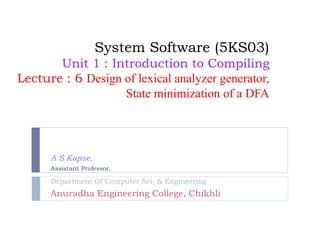
State Minimization DFA Lexical Analyzer
- 1. System Software (5KS03) Unit 1 : Introduction to Compiling Lecture : 6 Design of lexical analyzer generator, State minimization of a DFA A S Kapse, Assistant Professor, Department Of Computer Sci. & Engineering Anuradha Engineering College, Chikhli
- 2. Contents… Design of lexical analyzer generator, State minimization of a DFA
- 3. Objectives… Upon completion of this lecture, you will be able To understand the Lexical Analysis To understand Role of lexical analyses To understand input buffering & state minimization of DFA
- 4. Review…./ Concepts What do you mean by State? What do you mean by NFA & DFA? What do you mean by Parse tree?
- 5. 5 Deterministic and Nondeterministic Automata Deterministic Finite Automata (DFA) One transition per input per state No -moves Nondeterministic Finite Automata (NFA) Can have multiple transitions for one input in a given state Can have -moves Finite automata have finite memory Need only to encode the current state
- 6. 6 Execution of Finite Automata A DFA can take only one path through the state graph Completely determined by input NFAs can choose Whether to make -moves Which of multiple transitions for a single input to take
- 7. 7 Acceptance of NFAs An NFA can get into multiple states • Input: 0 1 1 0 1 0 1 • Rule: NFA accepts if it can get in a final state
- 8. 8 NFA vs. DFA (1) NFAs and DFAs recognize the same set of languages (regular languages) DFAs are easier to implement There are no choices to consider
- 9. 9 NFA vs. DFA (2) For a given language the NFA can be simpler than the DFA 0 1 0 0 0 1 0 1 0 1 NFA DFA • DFA can be exponentially larger than NFA
- 10. 10 Regular Expressions to Finite Automata High-level sketch Regular expressions NFA DFA Lexical Specification Table-driven Implementation of DFA
- 11. 11 Regular Expressions to NFA (1) For each kind of rexp, define an NFA Notation: NFA for rexp A A • For • For input a a
- 12. 12 Regular Expressions to NFA (2) For AB A B • For A | B A B
- 13. 13 Regular Expressions to NFA (3) For A* A
- 14. 14 Example of RegExp -> NFA conversion Consider the regular expression (1 | 0)*1 The NFA is 1C E 0D F B G A H 1 I J
- 16. 16 NFA to DFA. The Trick Simulate the NFA Each state of resulting DFA = a non-empty subset of states of the NFA Start state = the set of NFA states reachable through -moves from NFA start state Add a transition S a S’ to DFA iff S’ is the set of NFA states reachable from the states in S after seeing the input a considering -moves as well
- 17. 17 NFA -> DFA Example 1 0 1 A B C D E F G H I J ABCDHI FGABCDHI EJGABCDHI 0 1 0 1 0 1
- 18. 18 NFA to DFA. Remark An NFA may be in many states at any time How many different states ? If there are N states, the NFA must be in some subset of those N states How many non-empty subsets are there? 2N - 1 = finitely many, but exponentially many
- 19. 19 Implementation A DFA can be implemented by a 2D table T One dimension is “states” Other dimension is “input symbols” For every transition Si a Sk define T[i,a] = k DFA “execution” If in state Si and input a, read T[i,a] = k and skip to state Sk Very efficient
- 20. 20 Table Implementation of a DFA S T U 0 1 0 1 0 1 0 1 S T U T T U U T U
- 21. 21 Implementation (Cont.) NFA -> DFA conversion is at the heart of tools such as flex or jflex But, DFAs can be huge In practice, flex-like tools trade off speed for space in the choice of NFA and DFA representations
- 22. Video on Compilers 1. Design of lexical analyzer generator,
- 23. Questions.. 1. What are the steps associated with transformation from NFA to DFA? 2.
- 24. Homework.. 1. What is parser? 2. Define a translator and categorize it.
